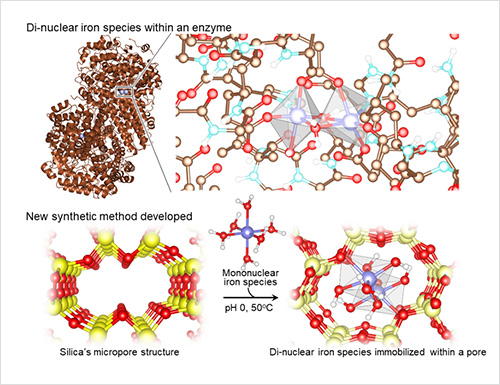 Press Release 2022
Press Release 2022
White Iron Rust Material Provides Safe UV Protection
—New Material May Serve as an Alternative to Titanium Dioxide as an Active Sunscreen Ingredient—
Hokkaido University
Hiroshima University
A research team consisting of NIMS, Hokkaido University and Hiroshima University has developed an iron oxide-based ultraviolet -absorbing powder material by stabilizing normally unstable, colorless, UV-absorbing di-nuclear iron species in porous silica.
“Layered Silicate Stabilises Diiron to Mimic UV-Shielding TiO2 Nanoparticle”
Hamza El-Hosainy, Shinya Mine, Takashi Toyao, Ken-ichi Shimizu, Nao Tsunoji, Mohaed Esmat, Esmail Doustkhah, Maged El-Kemary, Yusuke Ide ;
Journal: Materials Today Nano [May 26, 2022];
DOI : 10.1016/j.mtnano.2022.100227

Abstract
TiO2 has been used in a wide variety of products in various applications (e.g., as a white pigment, in UV protection (mainly by scattering and neutralizing UV radiation) and as a photocatalyst), including cosmetics, everyday items, food products, medical products and building materials. However, the European Union classified this substance as a category 2 carcinogen in 2020, causing its use and production to decline and leading France to ban the use of food-grade TiO2. Although Japan hasn’t restricted the use of TiO2, developing alternatives to it is an important national issue considering the size of the Japanese TiO2 market.
A di-nuclear iron species is a type of iron oxide in which a pair of iron atoms are linked by ligands of water molecules or hydroxy groups. This species exhibits higher photocatalytic activity than TiO2 when absorbing UV radiation. This ability separates it from other iron oxides that are used as a red food coloring. Although di-nuclear iron species are commonly found in enzymes and other proteins, they are unstable and difficult to synthesize. Their safe and stable use has long been a focus of research interest. This research team recently succeeded in stabilizing a di-nuclear iron species by embedding it in porous silica powder, thereby restricting it from transforming into a higher-order multinuclear iron species or crystallized iron oxide and reducing its harmful photocatalytic activities. The resulting product is a UV-absorbing white powder material. The team also prepared a sunscreen cream using this material as an active ingredient and found that its performance and stability were comparable to those of the TiO2 materials currently used in sunscreens.
This research team devised a procedure to synthesize the white powder material capable of absorbing and neutralizing UV radiation using ingredients safer than TiO2. This material may potentially be used to develop new cosmetics and sunscreens. In addition, the microporous structure of silica, which is used to stabilize di-nuclear iron species, can be modified to maximize the iron species’ photocatalytic activities. This approach may be applicable to the development of photocatalysts that can be used in air purifiers and other technologies. The team will pursue this possibility.
This project was carried out by a research team led by Yusuke Ide (Principal Researcher, International Center for Materials Nanoarchitectonics, NIMS), Shinya Mine (Postdoctoral Researcher, Institute for Catalysis (ICAT), Hokkaido University (HU)), Takashi Toyao (Assistant Professor, ICAT, HU), Ken-ichi Shimizu (Professor, ICAT, HU) and Nao Tsunoji (Assistant Professor, Graduate School of Advanced Science and Engineering, Hiroshima University). This work was supported by the JSPS Grants-in-Aid for Scientific Research (grant number: 21H02034).
This research was published in the online version of Materials Today Nano on May 26, 2022.
(Regarding this research)
Yusuke Ide
Principal Researcher/Acting Group Leader
Mesoscale Materials Chemistry Group, Nano-materials Field, MANA, NIMS
Tel: +81-29-860-4826
E-Mail: Ide.Yusuke=nims.go.jp
(Please change "=" to "@")
Shimizu Laboratory
Catalyst Material Research Division
Institute for Catalysis
Hokkaido University
Shinya Mine
Postdoctoral Researcher
E-Mail: mine=cat.hokudai.ac.jp
(Please change "=" to "@")
Takashi Toyao
Assistant Professor
Tel: +81-11-706-9165
E-Mail: toyao=cat.hokudai.ac.jp
(Please change "=" to "@")
Ken-ichi Shimizu
Professor
Tel: +81-11-706-9164
E-Mail: kshimizu=cat.hokudai.ac.jp
(Please change "=" to "@")
Nao Tsunoji
Assistant Professor
Sadakane-Tsunoji-Minato Laboratory
Applied Chemistry Program
Graduate School of Advanced Science and Engineering
Hiroshima University
Tel: +81-82-424-7606
E-Mail: tnao7373=hiroshima-u.ac.jp
(Please change "=" to "@")
(General information)
Public Relations Office
National Institute for Materials Science
Tel: +81-29-859-2026
Fax: +81-29-859-2017
E-Mail: pressrelease=ml.nims.go.jp
(Please change "=" to "@")
Public Relations Division
Hokkaido University
Kita 8, Nishi 5, Kita-ku, Sapporo, Hokkaido 060-0808, Japan
Tel: +81-11-706-2610
Fax: +81-11-706-2092
E-Mail: jp-press=general.hokudai.ac.jp
(Please change "=" to "@")
Public Relations Group
Hiroshima University
1-3-2 Kagamiyama, Higashi-Hiroshima-shi, Hiroshima 739-8511, Japan
Tel: +81-82-424-3749
Fax: +81-82-424-6040
E-Mail: koho=office.hiroshima-u.ac.jp
(Please change "=" to "@")

